Investigation of the Effects of Climate Change and Human Activities on the Spatio-Temporal Trends of Vegetation in the Source Region of the Yellow River in China
Abstract
1. Introduction
2. Materials and Methods
2.1. Study Area
2.2. Data Sources
2.3. Methods
2.3.1. Maximum Value Composite (MVC) Method
2.3.2. Linear Trend Analysis
2.3.3. Correlation Analysis
3. Results
3.1. Spatiotemporal Trends of Vegetation
3.1.1. Temporal Trends of Vegetation
3.1.2. Spatial Trends of Vegetation
3.2. Vegetation Changes Under the Influence of Climate Change
3.3. Vegetation Changes Under the Influence of Human Activities
3.4. Vegetation Changes Across Different Underlying Surfaces
4. Discussion
4.1. Climatic Changes and Vegetation Dynamics
4.2. Human Activities and Vegetation Dynamics
4.3. The Interplay of Climatic and Anthropogenic Drivers
4.4. Limitations
5. Conclusions
- (1)
- The region experienced a significant overall greening trend, yet this recovery is spatially heterogeneous and seasonally vulnerable. While vegetation improved across 92.7% of the area, the persistent and extensive degradation observed during the summer and autumn seasons, affecting approximately one-quarter of the region, underscores that the ecosystem’s recovery is fragile and susceptible to seasonal climatic stressors, particularly in southeastern low-altitude areas.
- (2)
- Climate change is the dominant driver of the large-scale greening pattern, but its effectiveness is contingent on hydrothermal coordination. Warming temperatures and increased precipitation jointly promoted vegetation growth, explaining the overarching positive trend. However, the observed degradation in the northwest and during summer-autumn reveals that warming alone is insufficient and can even be detrimental where water availability is limited, demonstrating that the matching of hydrothermal conditions is ultimately decisive for vegetation dynamics.
- (3)
- Human activities are critical drivers of localized degradation, acting as key modifiers of the spatially heterogeneous vegetation pattern. Rapid population growth, livestock expansion, and associated socio-economic development have significantly exacerbated grassland degradation, particularly in accessible low-altitude regions. These anthropogenic pressures interact with climatic limitations, shaping the specific spatial pattern of vegetation degradation and recovery.
Author Contributions
Funding
Institutional Review Board Statement
Informed Consent Statement
Data Availability Statement
Conflicts of Interest
References
- Jin, K.; Wang, F.; Han, J.; Shi, S.; Ding, W. Contribution of climatic change and human activities to vegetation NDVI change over China during 1982–2015. Acta Ecol. Sin. 2020, 75, 961–974. [Google Scholar] [CrossRef]
- Piao, S.; Friedlingstein, P.; Ciais, P.; Zhou, L.; Chen, A. Effect of climate and CO2 changes on the greening of the Northern Hemisphere over the past two decades. Geophys. Res. Lett. 2006, 33, 23. [Google Scholar] [CrossRef]
- Hu, Y.; Wang, H.; Niu, X.; Shao, W.; Yang, Y. Comparative Analysis and Comprehensive Trade-Off of Four Spatiotemporal Fusion Models for NDVI Generation. Remote Sens. 2022, 14, 5996. [Google Scholar] [CrossRef]
- Yang, L.; Guan, Q.; Lin, J.; Tian, J.; Tan, Z.; Li, H. Evolution of NDVI secular trends and responses to climate change: A perspective from nonlinearity and nonstationarity characteristics. Remote Sens. Environ. 2021, 254, 112247. [Google Scholar] [CrossRef]
- Li, P.; Wang, J.; Mengmeng, L.; Xue, Z.; Bagherzadeh, A.; Liu, M. Spatio-temporal variation characteristics of NDVI and its response to climate on the Loess Plateau from 1985 to 2015. Catena 2021, 203, 105331. [Google Scholar] [CrossRef]
- Zhang, Y.; Zhao, Z.; Li, S.; Meng, X. Indicating variation of surface vegetation cover using SPOT NDVI in the northern part of North China. Geogr. Res. 2008, 27, 745–754. [Google Scholar]
- Mao, D.; Wang, Z.; Luo, L.; Ren, C. Integrating AVHRR and MODIS data to monitor NDVI changes and their relationships with climatic parameters in Northeast China. Int. J. Appl. Earth Obs. Geoinf. 2012, 18, 528–536. [Google Scholar] [CrossRef]
- Zhang, C.; Hu, Y.; Shi, X. Analysis of spatial-temporal evolution of vegetation cover in loess plateau in recent 33 years based on AVHRR NDVI and MODIS NDVI. J. Appl. Sci 2016, 34, 702–712. [Google Scholar]
- Pang, G.; Wang, X.; Yang, M. Using the NDVI to identify variations in, and responses of, vegetation to climate change on the Tibetan Plateau from 1982 to 2012. Quat. Int. 2017, 444, 87–96. [Google Scholar] [CrossRef]
- Lai, J.; Qi, S.; Cui, R.; Liao, R.; Tang, Y.; Li, P. Analysis of Vegetation Change and Influencing Factors in Southwest Alpine Canyon Area. Environ. Sci. 2023, 44, 6833–6846. [Google Scholar] [CrossRef]
- Ma, B.; He, C.; Jing, J.; Wang, Y.; Liu, B.; He, H. Attribution of vegetation dynamics in Southwest China from 1982 to 2019. Acta Ecol. Sin. 2023, 78, 714–728. [Google Scholar] [CrossRef]
- Piao, S.; Yin, G.; Tan, J.; Cheng, L.; Huang, M.; Li, Y.; Liu, R.; Mao, J.; Myneni, R.B.; Peng, S. Detection and attribution of vegetation greening trend in China over the last 30 years. Glob. Change Biol. 2015, 21, 1601–1609. [Google Scholar] [CrossRef]
- Deng, C.; Bai, H.; Shan, G.; Liu, R.; Ma, X.; Huang, X.; Meng, Q. Spatial-temporal variation of the vegetation coverage in Qinling Mountains and its dual response to climate change and human activities. J. Nat. Resour. 2018, 33, 425–438. [Google Scholar] [CrossRef]
- Cao, B.; Zhang, B.; Ma, B.; Wang, G.; Tang, M.; Zhang, Y.; Jia, Y. Spatial and Temporal Variations of NDVI in Gansu, China from 2000 to 2014. J. Desert Res. 2018, 38, 418–427. [Google Scholar] [CrossRef]
- Ding, M.; Shen, Z.; Zhang, Y.; Liu, L.; Zhang, W.; Wang, Z.; Bai, W. VegetationChange along the Qinghai-Xizang Highway and Railway from 1981 to 2001. Resour. Sci. 2005, 27, 128–133. [Google Scholar]
- Zhang, M.; Zhu, K.; Lu, F.; Dai, Y.; Song, X.; Yu, S. Analysis of Changes of Hydrological Elements and Driving Factors in the Source Area of the Yellow River. Yellow River 2023, 45, 30–37. [Google Scholar]
- Guan, X.; Liu, C.; Bao, Z.; Jin, J.; Wang, G. Variation of Vegetation NDVI and Its Relationship with Climate Factors in the Yellow River Source Region. Res. Soil Water Conserv. 2021, 28, 268–277. [Google Scholar] [CrossRef]
- Liu, H.; Liu, F.; Zheng, L. Effects of Climate Change and Human Activities on Vegetation Cover Change in the Yellow River Basin. J. Soil Water Conserv. 2021, 35, 143–151. [Google Scholar] [CrossRef]
- Ma, S.; Bao, G.; Guo, G.; Yang, L.; Dai, Q.; Zhang, L. Change Trend of Vegetation and Its Responses to Climate Change in the Source Region of the Yellow Rive. J. Arid Meteorol. 2018, 36, 226–233. [Google Scholar]
- Gao, S.; Dong, G.; Jiang, X.; Nie, T.; Guo, X.; Dang, S.; Li, X.; Li, H. Analysis of vegetation coverage changes and natural driving forces of spatial distribution in the source region of the Yellow River. Ecol. Environ. Sci. 2022, 31, 429–439. [Google Scholar] [CrossRef]
- Mo, X.; Liu, S.; Hu, S. Co-evolution of climate-vegetation-hydrology and its mechanisms in the source region of Yellow River. Acta Ecol. Sin. 2022, 77, 1730–1744. [Google Scholar]
- Chu, L.; Huang, C.; Liu, G.; Liu, Q.; Zhao, J. Analysis on vegetation changes of Maqu alpine wetlands in the Yellow River source region. Land Surf. Remote Sens. II 2014, 9260, 92602O. [Google Scholar] [CrossRef]
- Yuan, Z.; Jiang, Q.; Yin, J. Impact of climate change and land use change on ecosystem net primary productivity in the Yangtze River and Yellow River Source Region, China. Watershed Ecol. Environ. 2023, 5, 125–133. [Google Scholar] [CrossRef]
- Lu, J.; Qin, T.; Yan, D.; Lv, X.; Yuan, Z.; Wen, J.; Xu, S.; Yang, Y.; Feng, J.; Li, W. Response of Vegetation to Drought in the Source Region of the Yangtze and Yellow Rivers Based on Causal Analysis. Remote Sens. 2024, 16, 630. [Google Scholar] [CrossRef]
- Wei, X.; Zhang, L.; He, Y.; Cao, S.; Sun, Q.; Gao, B. 2000–2020 spatiotemporal variations of different vegetation types in the Yellow River basin and influencing factors. Remote Sens. Nat. Resour. 2024, 36, 229–241. [Google Scholar] [CrossRef]
- Li, Z.; Rong, L.; Xin, W.; Zuoliang, W.; Jun, W.; Yang, Z.; Yan, X.; Tangtang, Z. The characteristics of the water vapor transport and associated sources under abnormal precipitation conditions in the source region of the Yellow River using FLEXPART. Plateau Meteorol. 2019, 38, 484–496. [Google Scholar]
- Holben, B.N. Characteristics of maximum-value composite images from temporal AVHRR data. Int. J. Remote Sens. 1986, 7, 1417–1434. [Google Scholar] [CrossRef]
- Wang, X.; Piao, S.; Ciais, P.; Li, J.; Friedlingstein, P.; Koven, C.; Chen, A. Spring temperature change and its implication in the change of vegetation growth in North America from 1982 to 2006. Proc. Natl. Acad. Sci. USA 2011, 108, 1240–1245. [Google Scholar] [CrossRef] [PubMed]
- Xu, H.; Liu, Q. Analysis of Vegetation NDVI Dynamic and Its Relationship with Climatic Factors in Yunnan Province During 2001–2019. Res. Soil Water Conserv. 2022, 29, 162–168. [Google Scholar] [CrossRef]
- Chen, C.B.; Li, G.Y. Temporal and Spatial Variation of Grassland NDVI in Kunlun Mountains, Altun Mountains and Its Responses to Temperature and Precipitation from 1981 through 2020. Chin. J. Grassl. 2023, 45, 13–25. [Google Scholar] [CrossRef]
- Wang, X.; Li, Y.; Lian, J.; Duan, Y.; Wang, L. Relationship between vegetation coverage and climate change in semiarid sandy land and the significance to ecological construction. J. Desert Res. 2021, 41, 183–194. [Google Scholar]
- Sun, Q.; Li, B.; Zhou, G.; Jiang, Y.; Yuan, Y. Delayed autumn leaf senescence date prolongs the growing season length of herbaceous plants on the Qinghai–Tibetan Plateau. Agric. For. Meteorol. 2020, 284, 107896. [Google Scholar] [CrossRef]
- Piao, S.; Wang, X.; Park, T.; Chen, C.; Lian, X.; He, Y.; Bjerke, J.W.; Chen, A.; Ciais, P.; Tømmervik, H. Characteristics, drivers and feedbacks of global greening. Nat. Rev. Earth Environ. 2020, 1, 14–27. [Google Scholar] [CrossRef]
- Xu, L.; Gao, G.Y.; Wang, X.F.; Chen, Y.Z.; Zhou, C.W.; Wang, K.; Fu, B.J. Quantifying the contributions of climate change and human activities to vegetation greening in the drylands of northern China. Acta Ecol. Sin. 2023, 43, 7274–7283. [Google Scholar] [CrossRef]
- Qu, S.; Wang, L.; Lin, A.; Yu, D.; Yuan, M.; Li, C.a. Distinguishing the impacts of climate change and anthropogenic factors on vegetation dynamics in the Yangtze River Basin, China. Ecol. Indic. 2020, 108, 105724. [Google Scholar] [CrossRef]
- Du, M.; Kawashima, S.; Yonemura, S.; Zhang, X.; Chen, S. Mutual influence between human activities and climate change in the Tibetan Plateau during recent years. Glob. Planet. Change 2004, 41, 241–249. [Google Scholar] [CrossRef]
- Wang, G.; Cheng, G. Characteristics of Grassland and Ecological Changes of Vegetations in the Source Regions of Yangtze and Yellow Rivers. J. Desert Res. 2001, 21, 101–107. [Google Scholar]
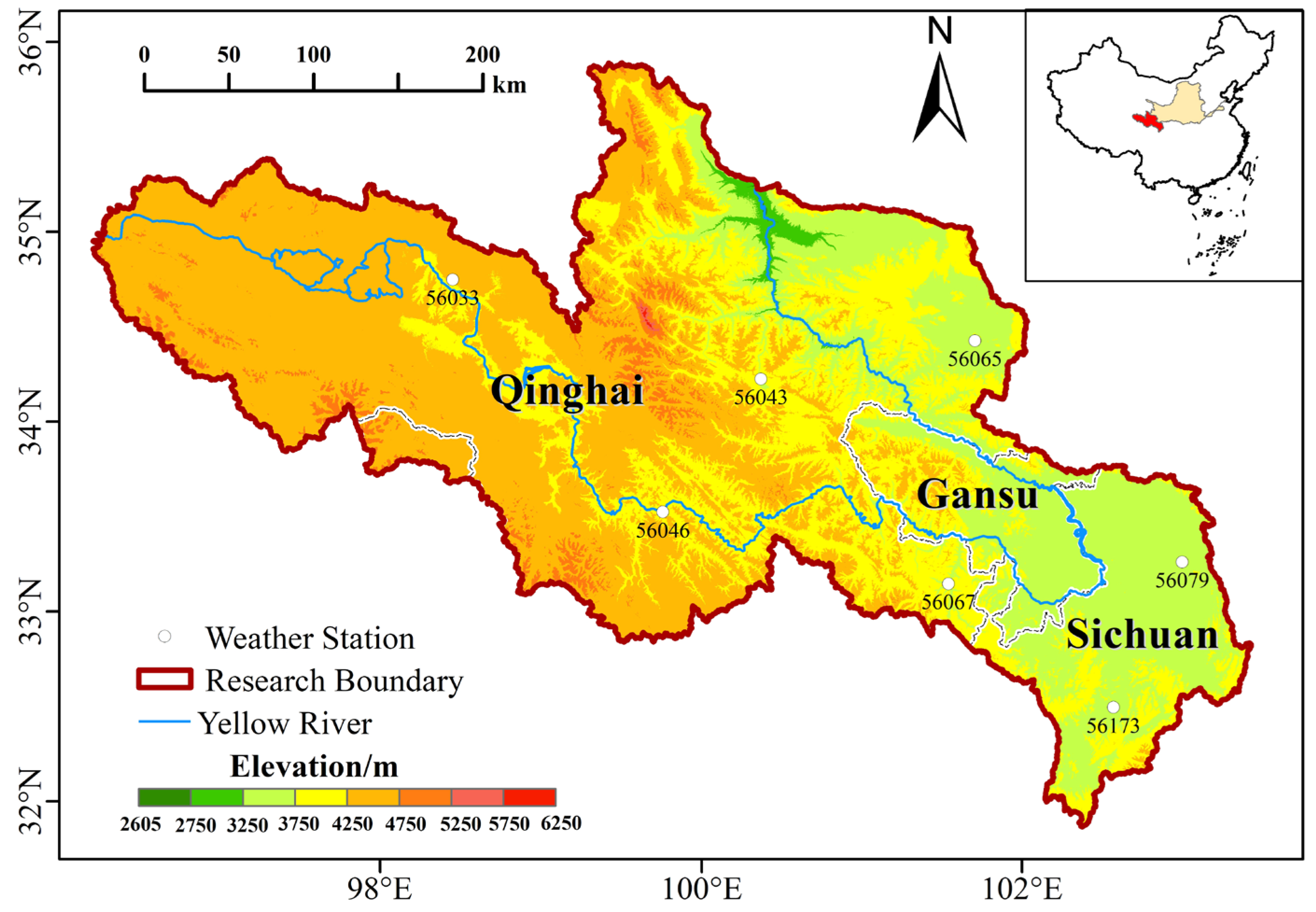


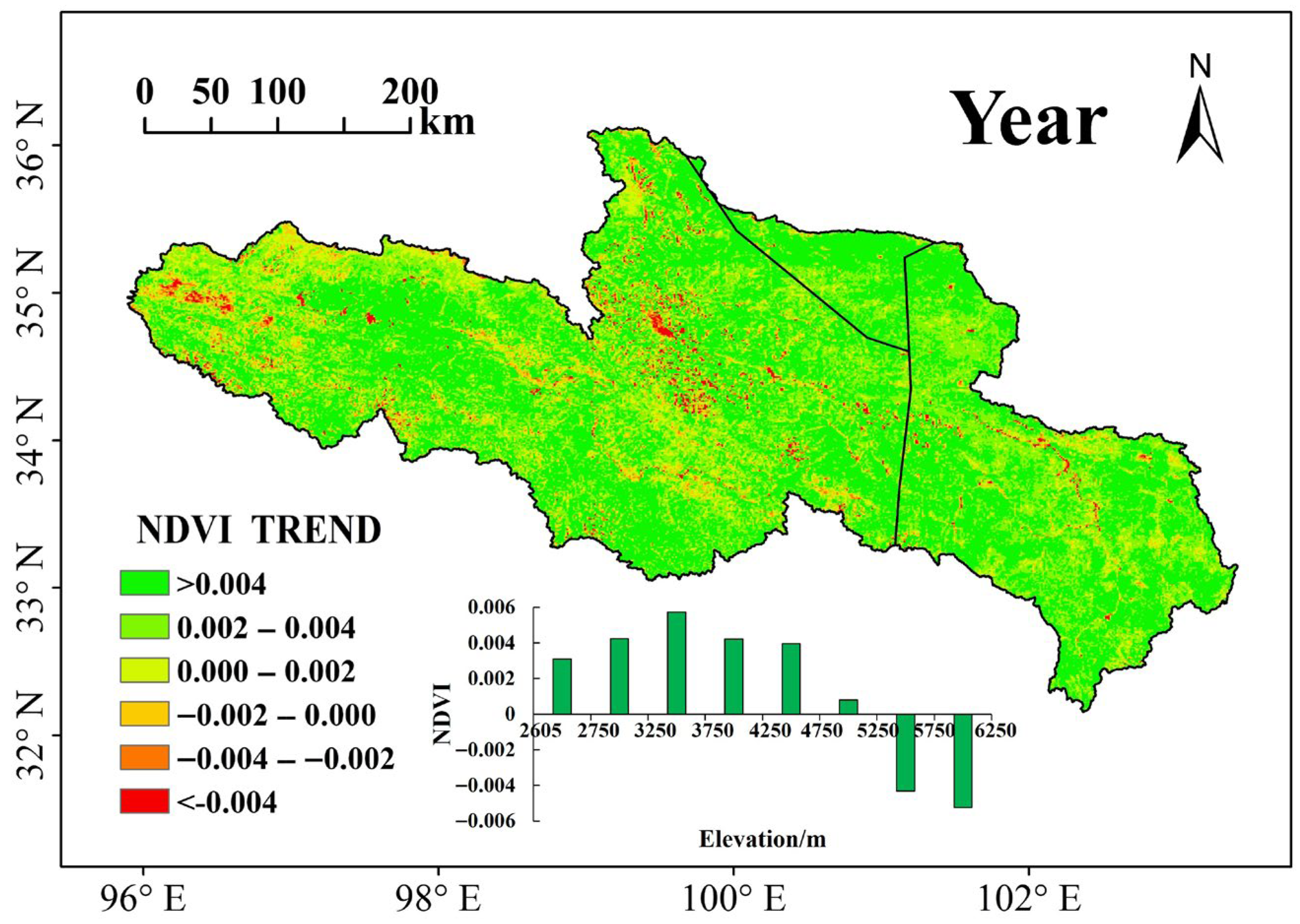
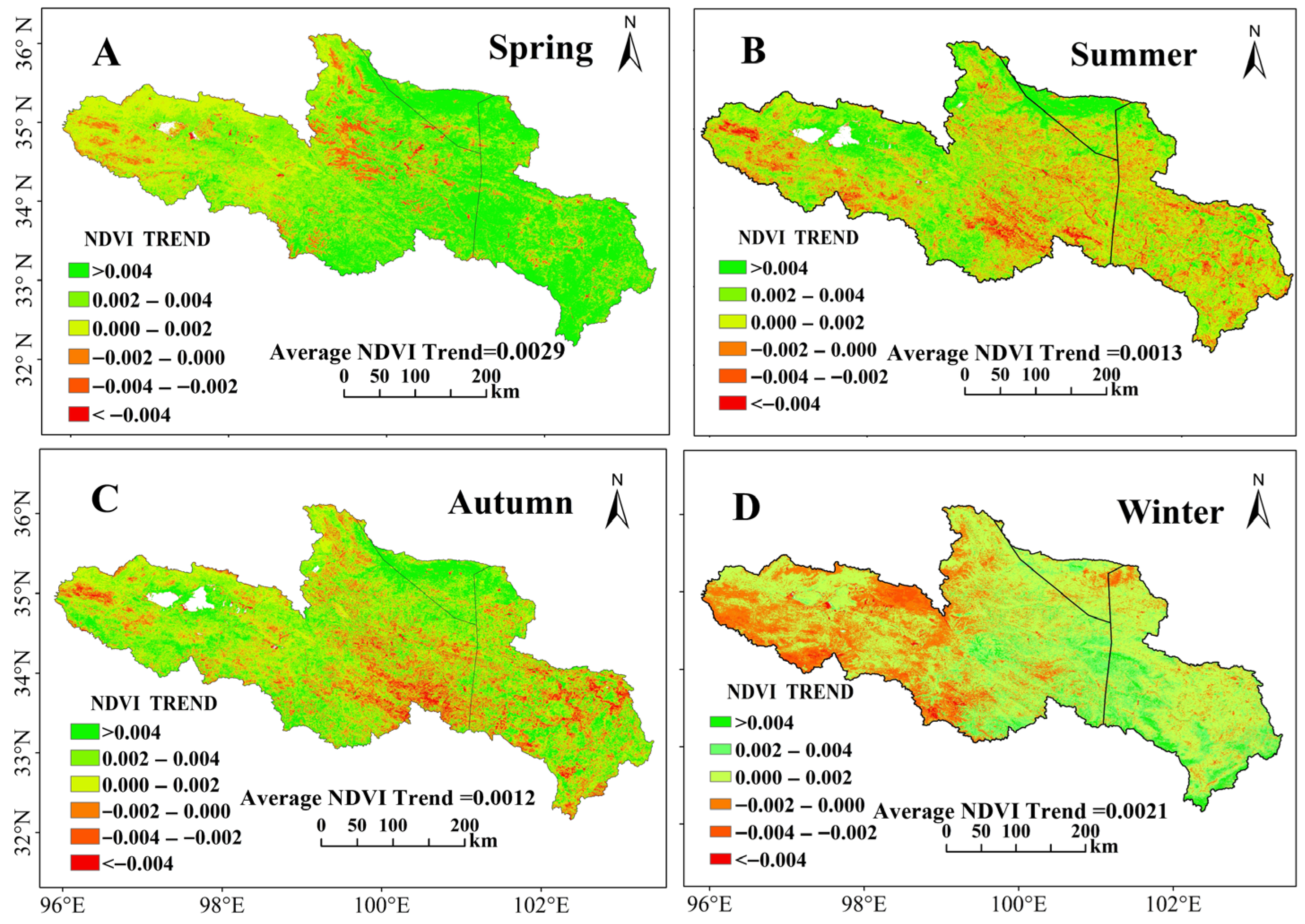


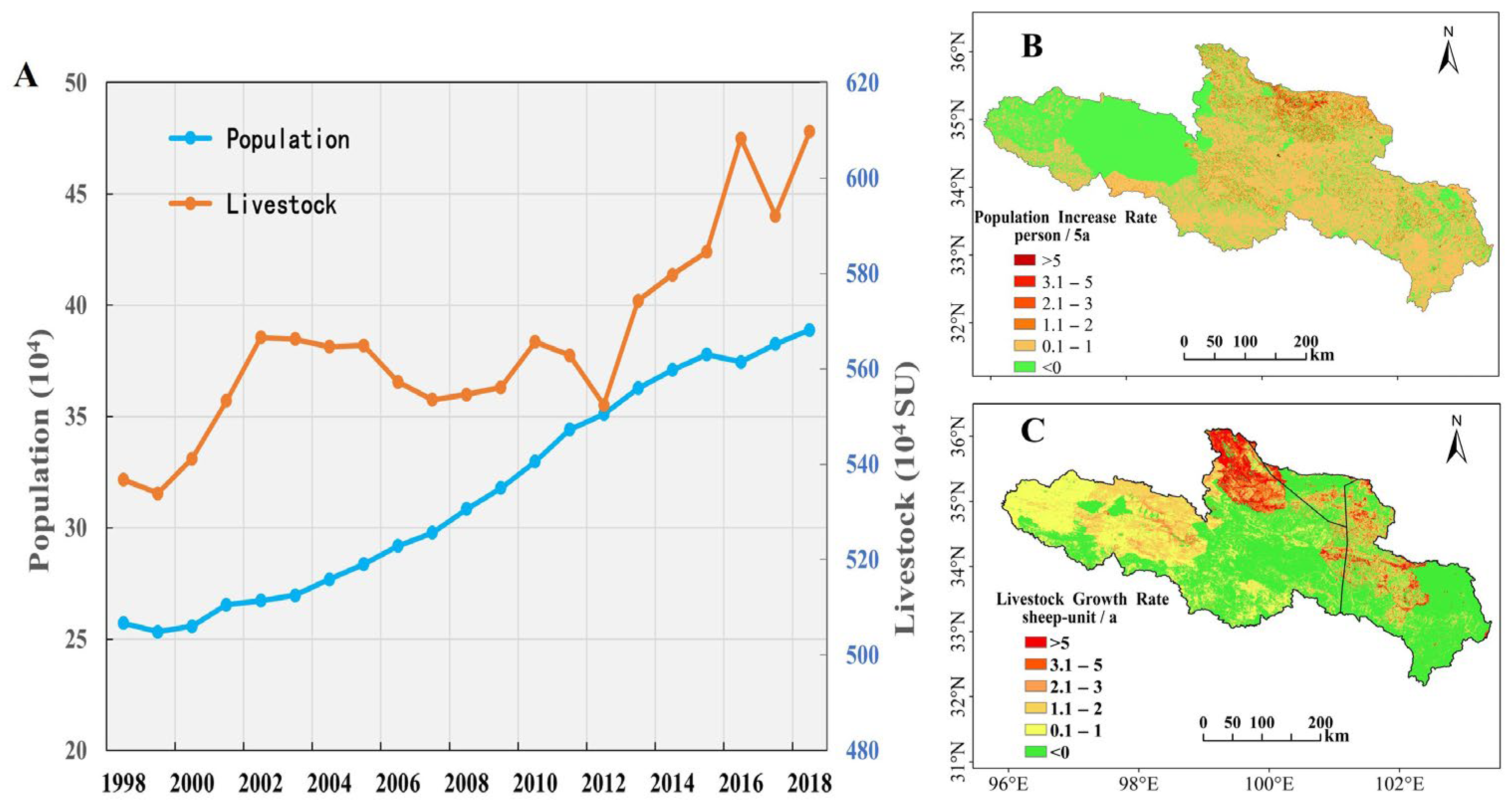

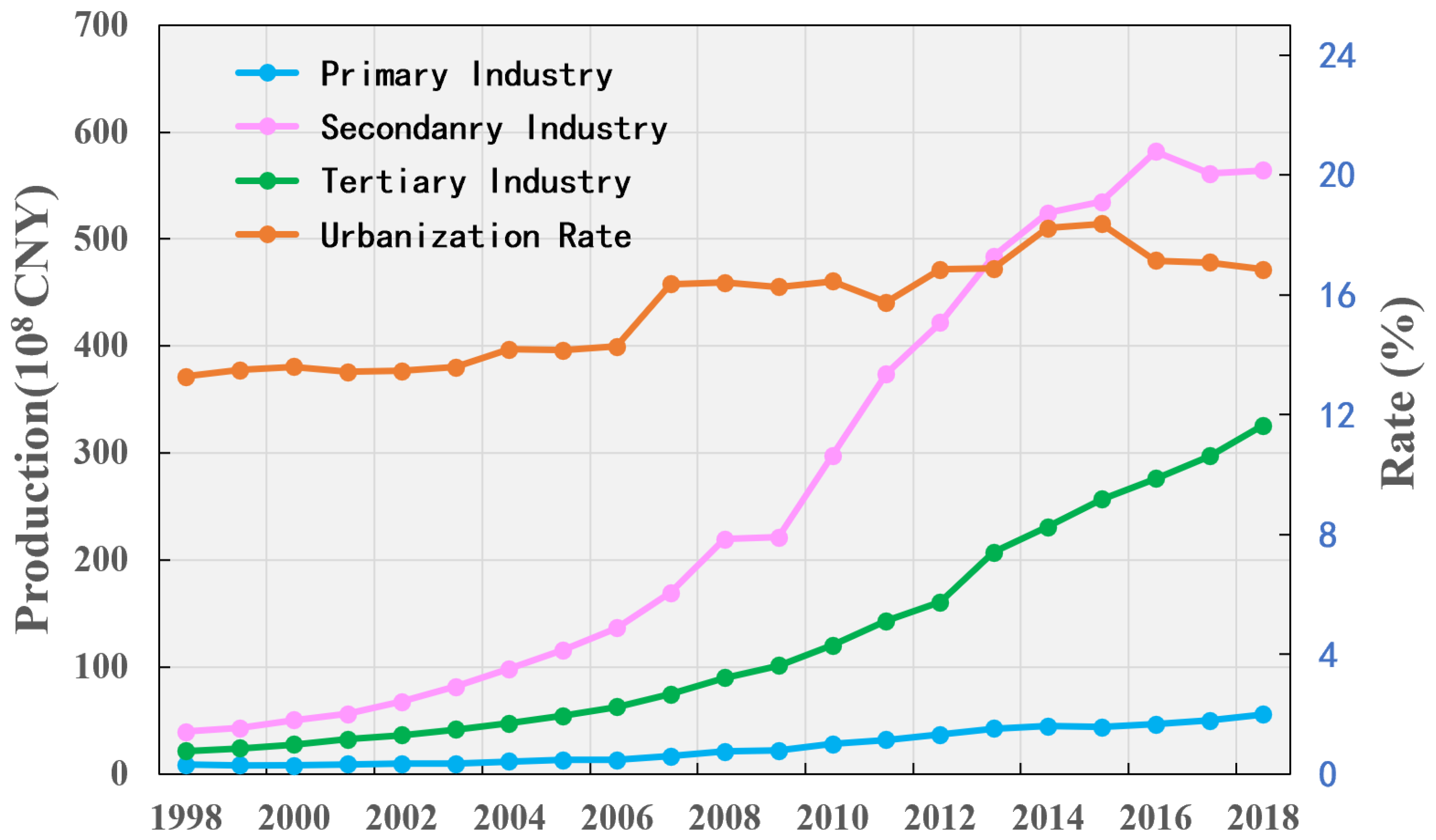
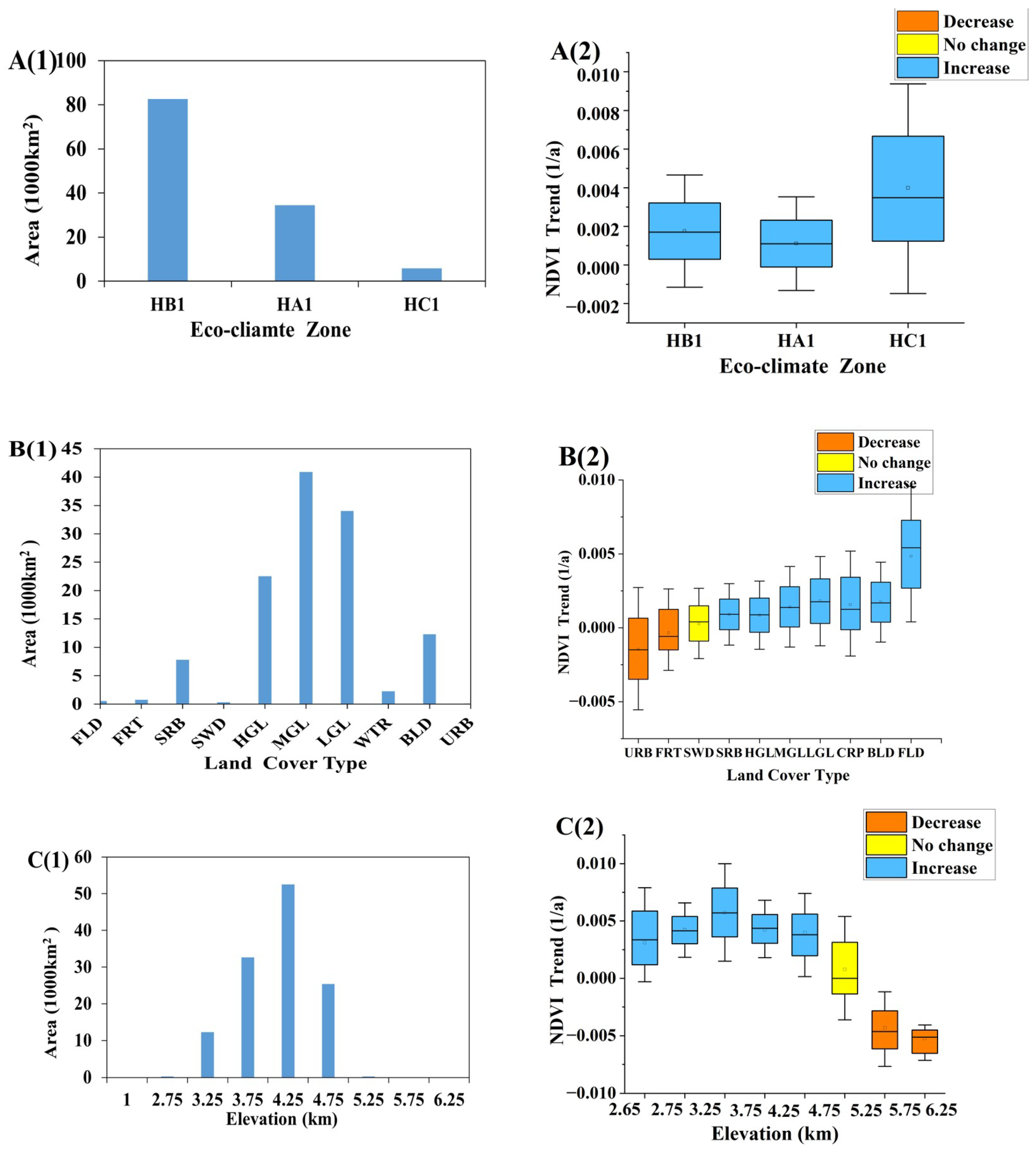
| Season | Temperature | Precipitation | ||
|---|---|---|---|---|
| r | p-Value | r | p-Value | |
| Spring | 0.66 | <0.01 | 0.60 | <0.01 |
| Summer | 0.69 | <0.01 | 0.66 | <0.01 |
| Autumn | 0.31 | 0.16 | 0.21 | 0.37 |
| Winter | 0.52 | <0.01 | 0.02 | 0.94 |
Disclaimer/Publisher’s Note: The statements, opinions and data contained in all publications are solely those of the individual author(s) and contributor(s) and not of MDPI and/or the editor(s). MDPI and/or the editor(s) disclaim responsibility for any injury to people or property resulting from any ideas, methods, instructions or products referred to in the content. |
© 2025 by the authors. Licensee MDPI, Basel, Switzerland. This article is an open access article distributed under the terms and conditions of the Creative Commons Attribution (CC BY) license (https://creativecommons.org/licenses/by/4.0/).
Share and Cite
Deng, W.; Lv, X.; Ni, Y.; Ma, L.; Zhang, Q.; Wang, J.; Zhang, H.; Wen, X.; Cheng, W. Investigation of the Effects of Climate Change and Human Activities on the Spatio-Temporal Trends of Vegetation in the Source Region of the Yellow River in China. Sustainability 2025, 17, 9399. https://doi.org/10.3390/su17219399
Deng W, Lv X, Ni Y, Ma L, Zhang Q, Wang J, Zhang H, Wen X, Cheng W. Investigation of the Effects of Climate Change and Human Activities on the Spatio-Temporal Trends of Vegetation in the Source Region of the Yellow River in China. Sustainability. 2025; 17(21):9399. https://doi.org/10.3390/su17219399
Chicago/Turabian StyleDeng, Wenyan, Xizhi Lv, Yongxin Ni, Li Ma, Qiufen Zhang, Jianwei Wang, Hengshuo Zhang, Xin Wen, and Wenjie Cheng. 2025. "Investigation of the Effects of Climate Change and Human Activities on the Spatio-Temporal Trends of Vegetation in the Source Region of the Yellow River in China" Sustainability 17, no. 21: 9399. https://doi.org/10.3390/su17219399
APA StyleDeng, W., Lv, X., Ni, Y., Ma, L., Zhang, Q., Wang, J., Zhang, H., Wen, X., & Cheng, W. (2025). Investigation of the Effects of Climate Change and Human Activities on the Spatio-Temporal Trends of Vegetation in the Source Region of the Yellow River in China. Sustainability, 17(21), 9399. https://doi.org/10.3390/su17219399







